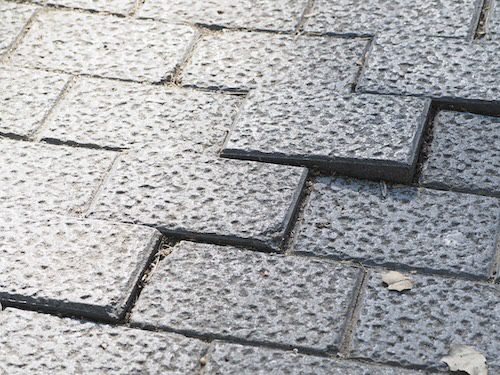Have you ever examined your driveway, patio, sidewalks, foundation, or any other part of your home’s exterior that has concrete? You’re not alone if you’ve ever discovered cracks or unlevel concrete. Nearly every home or business will develop cracks in the concrete throughout the years, most causing minor issues while others signal major issues like structural damage and foundation damage.
But why does concrete crack and become unlevel if it’s such a sturdy material? Keep reading as we discuss the 3 most common reasons why your concrete is unlevel and how to fix it so it doesn’t worsen or cause more damage.
3 Common Reasons Why Concrete is Unlevel
Unlevel concrete is a common issue for homeowners and commercial business owners. Here are the most common reasons why concrete becomes unlevel:
1. Unfortified & Settled Soil
Your home or commercial property was built on soil. Whether a concrete slab or blocks hold the weight of your entire home, anything that gets built begins in the soil. Construction crews dig until they reach the frost line in soil, anywhere from 1-eight feet below ground. Why? Most building codes require foundations to begin deep enough in the ground to avoid the soil contracting and expanding which can cause the soil to shift and crack.
Though construction crews dig deep up to code, the soil will settle through time, causing concrete driveways, patios, and slabs to crack and become unlevel. Soil naturally shifts thanks to water and air constantly weaving in and out of the soil, causing it to settle over and over again.
2. Improper Compaction/Installation
There’s more than meets the eye when it comes to pouring concrete; companies use precise installation practices to ensure the concrete has the right compaction, reinforcement, and curing time. All these factors are like a domino effect, each affecting the other and either aiding or weakening the strength of concrete.
Unfortunately, some companies or individuals attempting a DIY concrete leveling job make mistakes when compacting the soil, pouring the concrete, improper mixture with too little or too much water, and the time it takes to cure. It’s also crucial to pay attention to the weather when installing and pouring concrete, as warm temperatures speed up the moisture loss in curing concrete and cold weather can negatively affect the curing and strength of the concrete.
3. Poor Drainage
Another reason why concrete becomes unlevel is because of poor drainage. Though concrete patios, driveways, foundations, and walkways are exposed to the elements and frequently get exposed to moisture and precipitation, they should be installed so water doesn’t remain on top or alongside them, causing cracks and unlevel concrete.
Poor drainage can happen from improper grading and a faulty gutter system that allows water to overflow or leak, causing it to accumulate alongside a foundation or on driveways, patios, and other concrete slabs. A concrete foundation exposed to standing water can lead to cracks and an unlevel home while patios and sidewalks can also develop significant damage.
How to Fix Unlevel Concrete
Unlevel concrete is an unsightly and dangerous problem for homeowners and commercial business owners. Unlevel concrete is an eyesore that puts your home at risk of furthering foundation or concrete damage, is a safety risk causing trips and falls and can lead to costly structural damage that requires immediate repair.
Fortunately, fixing unlevel concrete is easy if you choose the right concrete leveling technique and hire a reputable, experienced company. Unlevel concrete requires a professional to fix, and two techniques exist: mudjacking and polyjacking. Though mudjacking is initially less expensive, it’s a temporary solution that makes polyjacking more affordable in the long run.
Mudjacking involves drilling large holes in unlevel concrete and pumping a mixture of concrete and organic materials like sand or dirt to lift it. Though it’s a decent concrete leveling technique, it’s not a permanent solution like polyjacking. The polyjacking process involves drilling tiny holes and pumping polyurethane foam underneath the concrete to permanently lift it. Polyjacking offers many benefits and is a permanent solution because it’s the only concrete leveling technique that fortifies the soil, never needing to be redone because of shifting soil.
Trust Pro Polyjacking with Your Concrete Leveling Project
For foundation repair, uneven concrete, and cracked concrete, consider polyjacking from Pro Polyjacking. This process stabilizes the soil and, as a result, lifts the concrete to fix cracks and level the foundation.
Foundation cracks and other damages are unsightly, especially if they’re on a commercial building you own or your home’s foundation. Trust the professionals at Pro Polyjacking in Kansas City for your concrete repair. We have over thirty years of experience, are proudly family-owned, and have an A rating from the Better Business Bureau and plenty of 5-star reviews from satisfied customers.
Contact the team at Pro Polyjacking for more information about our concrete leveling service!
